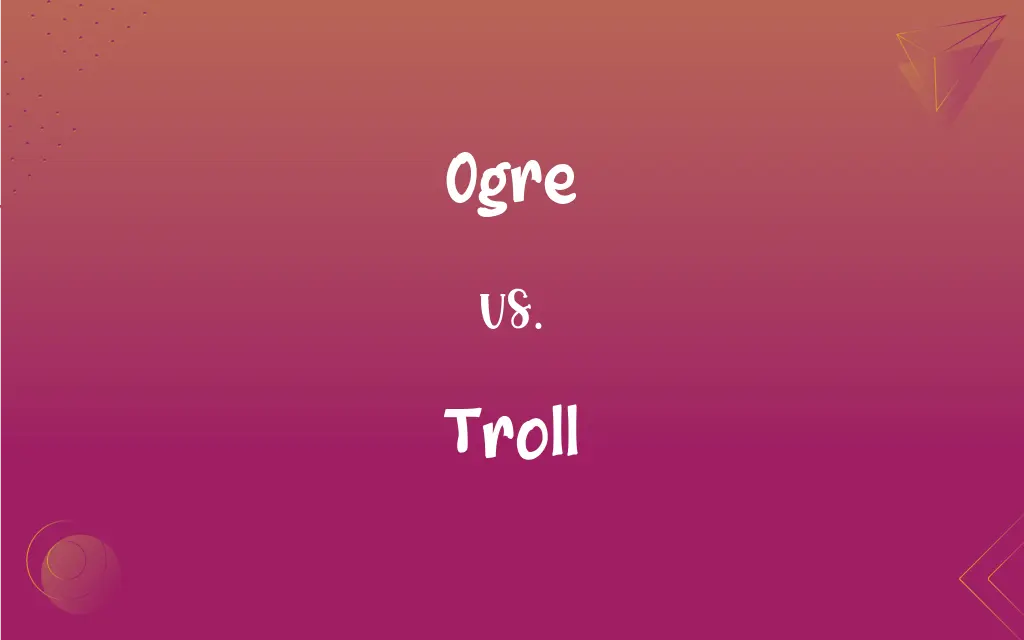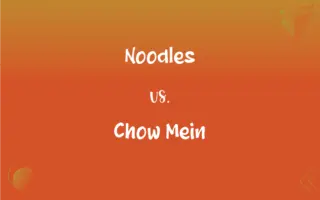Ogre vs. Troll: What's the Difference?
Edited by Aimie Carlson || By Harlon Moss || Published on December 17, 2023
An ogre is a large, fearsome creature of folklore, often depicted as eating humans, while a troll is a mythical being known for its ugliness and dwelling under bridges or in caves.

Key Differences
Ogres are typically portrayed as large, brutish beings in folklore, often associated with cannibalism. In contrast, trolls are commonly depicted as ugly and slow-witted, known for living under bridges or in caves.
The concept of an ogre is found in various cultures, depicted as a humanoid monster that preys on humans. On the other hand, trolls have a strong presence in Norse mythology and Scandinavian folklore, often as mischievous or malevolent.
In many stories, ogres are solitary creatures with a penchant for terrorizing villages. Conversely, trolls are often shown as being averse to sunlight, which in some tales, turns them to stone.
Ogres are frequently featured in fairy tales and fantasy literature as antagonists. Meanwhile, trolls are also popular in modern fantasy and are sometimes depicted as bridge guardians demanding tolls.
The depiction of ogres in popular media varies, but they are often shown as towering, muscular, and intimidating. In contrast, trolls are usually represented with distinct features like large noses, and in modern internet slang, a 'troll' refers to someone who provokes or harasses online.
ADVERTISEMENT
Comparison Chart
Origin
Various cultural folklore
Norse mythology, Scandinavian folklore
Habitat
Isolated places, forests
Under bridges, caves, mountains
Behavior
Often cannibalistic, fearsome
Mischievous, malevolent, sunlight-averse
Appearance in Stories
Antagonists in fairy tales
Bridge guardians, characters in fantasy
Physical Description
Large, brutish, humanoid
Ugly, often grotesque, distinct features
ADVERTISEMENT
Ogre and Troll Definitions
Ogre
A mythical giant often depicted as eating humans.
The ogre in the story lived in a dark, secluded castle.
Troll
A creature in folklore known for its ugliness and living in isolated places.
The troll under the bridge scared anyone who tried to cross.
Ogre
A character in fairy tales symbolizing physical and moral monstrosity.
In the fairy tale, the ogre kidnapped the princess.
Troll
In Norse legends, a being with magical powers and a dislike of humans.
The troll used its magic to protect its treasure.
Ogre
Often used metaphorically to describe a very cruel or terrifying person.
The tyrant was often referred to as an ogre by his subjects.
Troll
A term in modern internet culture for someone who intentionally stirs up trouble online.
He was banned from the forum for trolling other users.
Ogre
A figure in folklore, representing fear and danger.
Children were warned about the ogre who roamed the woods.
Troll
Often depicted in stories as being turned to stone by sunlight.
The troll was caught outside at dawn and turned to stone.
Ogre
Sometimes depicted as lonely giants seeking human interaction.
The ogre just wanted to find a friend in the story.
Troll
A character in fantasy literature and games, varying from evil to misunderstood.
In the game, trolls were powerful but not necessarily evil creatures.
Ogre
A giant or monster in legends and fairy tales that eats humans.
Troll
To fish for by trailing a baited line from behind a slowly moving boat.
Ogre
A person who is considered particularly cruel, brutish, or ugly.
Troll
To fish in by trailing a baited line
Troll the lake for bass.
Ogre
(mythology) A type of brutish giant from folk tales that eats human flesh.
Ogre
(figuratively) A brutish man reminiscent of the mythical ogre.
Ogre
An imaginary monster, or hideous giant of fairy tales, who lived on human beings; hence, any frightful giant; a cruel monster.
His schoolroom must have resembled an ogre's den.
Ogre
A cruel wicked and inhuman person
Ogre
(folklore) a giant who likes to eat human beings
FAQs
Can ogres be found in different cultures?
Yes, with variations in characteristics across cultures.
What is an ogre?
A large, monstrous creature in folklore, often cannibalistic.
Do ogres appear in children's fairy tales?
Yes, often as villains or frightening figures.
Are ogres always evil in stories?
Typically, but some stories depict them more sympathetically.
Are trolls always depicted as living under bridges?
Not always, but it's a common theme in many stories.
What kind of stories feature ogres?
Fairy tales, folklore, and fantasy literature.
What is a troll?
A mythical creature known for ugliness and dwelling in isolated places.
How are trolls used in modern internet slang?
As a term for someone who provokes or harasses others online.
Are trolls often involved in magic in mythology?
Yes, some stories attribute magical abilities to them.
What physical traits are associated with ogres?
Large size, muscular build, and intimidating appearance.
Do ogres have magical powers?
Generally, no, they are more known for physical strength.
What is the cultural significance of trolls?
They represent various human fears and moral lessons in folklore.
Are there different types of trolls?
Yes, ranging from mountain trolls to forest trolls in various tales.
Do trolls have a specific appearance?
Typically ugly and grotesque, but specifics vary by story.
Where do trolls originate from in folklore?
Primarily from Norse mythology and Scandinavian folklore.
What happens to trolls in sunlight, according to folklore?
They are often said to turn to stone in sunlight.
Do ogres play a role in modern media?
Yes, in movies, books, and games, often with diverse portrayals.
Can ogres speak in folklore stories?
In many tales, they can speak and often express brutish behavior.
How do trolls interact with humans in tales?
Often negatively, either tricking or threatening them.
Is the concept of ogres used metaphorically?
Yes, often to describe someone very cruel or terrifying.
About Author
Written by
Harlon MossHarlon is a seasoned quality moderator and accomplished content writer for Difference Wiki. An alumnus of the prestigious University of California, he earned his degree in Computer Science. Leveraging his academic background, Harlon brings a meticulous and informed perspective to his work, ensuring content accuracy and excellence.
Edited by
Aimie CarlsonAimie Carlson, holding a master's degree in English literature, is a fervent English language enthusiast. She lends her writing talents to Difference Wiki, a prominent website that specializes in comparisons, offering readers insightful analyses that both captivate and inform.






































































